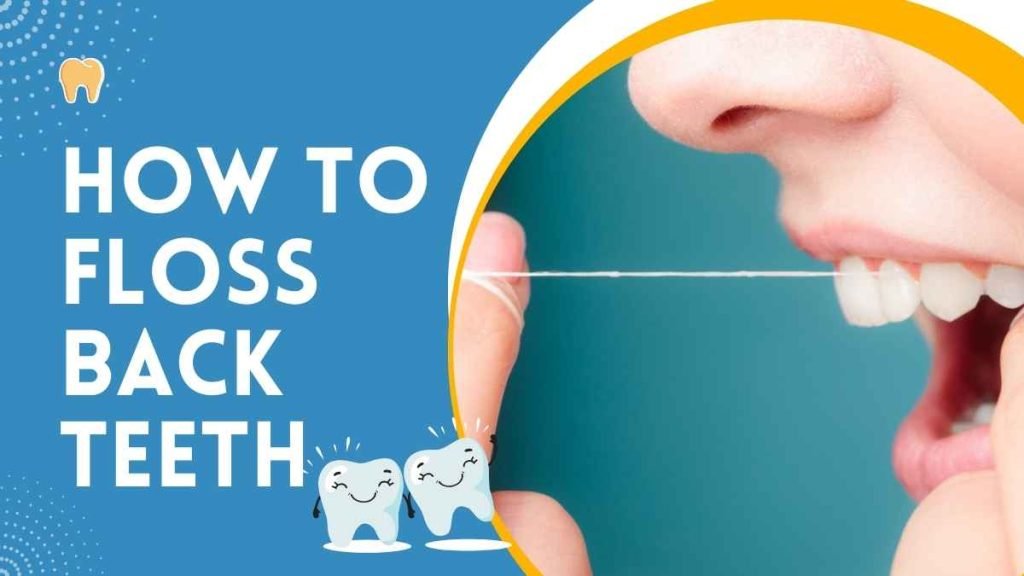How to Floss Back Teeth! Welcome to your comprehensive guide on mastering the art of flossing, specifically targeting those hard-to-reach back teeth. Achieving optimal oral hygiene isn’t just about brushing; it’s about the often-neglected task of flossing. In this detailed guide, we will explore How to Floss Back Teeth. Here we’ll delve into the nuances of flossing your back teeth, exploring proper techniques, common mistakes, and everything in between. So, let’s roll up our sleeves and embark on this journey towards a healthier smile!
Table of Contents
What Are the Benefits of Flossing?
Flossing is like giving your teeth a hug. It reaches where your toothbrush can’t, removing plaque and food particles nestled between your teeth. By flossing regularly, you’re preventing cavities, gum disease, and bad breath. Think of it as a mini spa day for your gums, keeping them healthy and happy.
How to Floss Properly
Flossing isn’t a race; it’s a meticulous process. Start with an 18-inch strand of dental floss. Wind most of it around your middle fingers, leaving an inch or two to work with. Hold the floss tightly between your thumbs and forefingers, gently sliding it between your teeth using a sawing motion. Curve the floss into a C shape against one tooth and carefully glide it into the space between the gum and the tooth. Don’t forget the back teeth; they deserve love too!

How to Floss Back Teeth: A Step-by-Step Guide
Here you can check the step-by-step guide about How to Floss Back Teeth:
Total Time: 10 minutes
Start with Clean Hands
Wash your hands thoroughly before reaching for the floss. Clean hands mean a cleaner mouth.
Choose the Right Floss
Opt for waxed floss or dental tape for easy maneuvering, especially between tight back teeth.
Be Gentle, Not Forceful
Glide the floss gently, avoiding snapping it between your teeth, which can injure your gums.
Slide, Don’t Pop
Slide the floss up and down against the tooth surface instead of popping it in and out abruptly.
Use a New Section
As you move from tooth to tooth, use a new section of the floss. Reusing the same area can spread bacteria.
What Is the Best Type of Floss?
Choosing the right floss can make a significant difference in your flossing experience. Waxed floss slides more smoothly between teeth, making it ideal for tight spaces. Dental tape, a flat, wide floss, is excellent for larger gaps between teeth. Interdental brushes, resembling tiny bottle brushes, are fantastic for back teeth with wider spaces. Experiment to find what suits you best; everyone’s teeth are unique!
How to Get Floss Stuck Between the Teeth Out
Ah, the classic floss stuck between teeth scenario. Don’t worry; it happens to the best of us! Instead of panicking, follow these steps:
- Stay Calm: Take a deep breath. Panicking might worsen the situation.
- Use More Floss: Take another piece of floss and gently try to ease out the stuck floss by moving it up and down.
- Rinse with Water: A gentle rinse can sometimes dislodge the stuck floss.
- Avoid Force: Never use sharp objects; you might injure your gums. Patience is the key.
How to Stop Gum Pain After Flossing
Gum pain after flossing can be a real buzzkill. Here’s how you can ease the discomfort:
- Rinse Your Mouth: Use warm salt water to rinse your mouth; it helps reduce inflammation.
- Choose Softer Floss: If your gums are sensitive, opt for soft, cushioned floss to minimize irritation.
- Proper Technique: Ensure you’re not being too aggressive. Floss gently to avoid injuring your gums.
- Regular Flossing: With time, as your gums get used to regular flossing, the pain should decrease.
Some Other Methods for Flossing Back Teeth
Flossing isn’t the only way to keep your back teeth in top-notch condition. Consider these alternatives:
- Water Flossers: These devices use a stream of water to remove plaque and debris between teeth, including the back ones.
- Interdental Brushes: Perfect for larger gaps, these small brushes reach between teeth, removing leftover food and plaque.
- Proxy Brushes: Also known as Christmas tree brushes, these are excellent for cleaning between teeth and around braces.
Common Mistakes to Avoid
Flossing may seem straightforward, but common mistakes can hinder its effectiveness. Avoid these blunders for a healthier smile:
- Rushing: Flossing should take time. Rushing can lead to inadequate cleaning.
- Skipping Days: Consistency is key. Make flossing a daily ritual to maintain oral health.
- Being Too Rough: Aggressive flossing can damage gums and teeth. Be gentle yet thorough.
Tips and Tricks
- Set Reminders: If you tend to forget, set a daily reminder on your phone until flossing becomes a habit.
- Flossing Tools: Experiment with various flossing tools to find what suits you best.
- Reward Yourself: Treat yourself to a small reward for sticking to your flossing routine. Positive reinforcement works wonders!
Facts About It
Did you know that flossing not only keeps your teeth and gums healthy but can also save you money? Preventing dental issues through regular flossing means fewer dental visits and procedures, saving you both time and dollars in the long run.
Conclusion
In conclusion of How to Floss Back Teeth, you’ve just mastered the art of flossing your back teeth. Remember, oral hygiene is a lifelong commitment, and your teeth deserve the best care. By incorporating proper flossing techniques into your daily routine and exploring alternative methods, you’re well on your way to a healthier smile and fresher breath. So, go ahead, flash that confident, flossed smile to the world! Here you can checkout that How to Reduce Gap Between Teeth Naturally at Home.
FAQs About How to Floss Back Teeth
How often should I floss my back teeth?
Floss your back teeth at least once a day, preferably before bedtime, to remove plaque and food particles.
Can I reuse a piece of floss for multiple teeth?
It’s best to use a new section of floss for each tooth to prevent spreading bacteria.
Are water flossers as effective as traditional floss?
Water flossers are effective at removing plaque, but they might not be as precise as traditional floss, especially for tightly spaced back teeth.
Should I floss before or after brushing my teeth?
Dental experts recommend flossing before brushing. Flossing first loosens debris, allowing the toothbrush to clean more effectively.
Can children use dental floss?
Yes, children can use dental floss. There are special flosses designed for kids with smaller hands and teeth.
What if my gums bleed while flossing?
If your gums bleed, it could be a sign of gum disease. Be gentle while flossing, and if bleeding persists, consult a dentist.
How long should I spend flossing my back teeth?
Spend at least 2-3 minutes flossing your back teeth, ensuring you clean between each tooth thoroughly.


